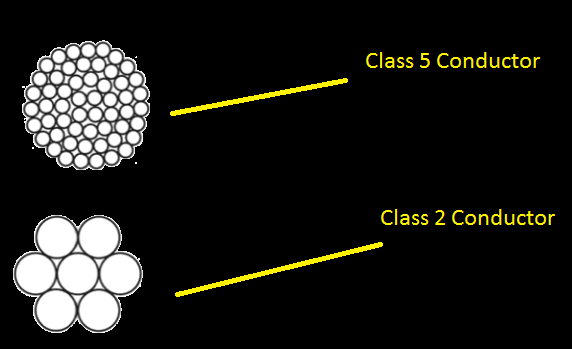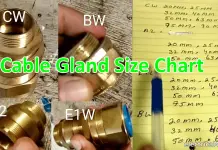Aluminium and Copper Current Carrying Capacity Calculation Chart in Sqmm:
Aluminium and copper are the most available material in the earth, but the copper conductor carries 40% extra current than the aluminium conductor.
But the cost to sqmm points of view, i.e the cost of 3 core 35sqmm aluminium cable has Rs 1.6per sq. meter and copper conductor has Rs 3.0 per sqmm. However, the aluminium cables are much cheaper than the copper cable.
However, in this article, we are going to see how to get cable capacity using Aluminium and Copper Current Carrying Capacity Calculation chart.
Also see:
- What is Busbar Current Carrying Capacity Calculation 5 Types of Busbar
- How to calculate the current carrying capacity of Carbon Brushes
- Top 6 Difference Between Copper and Aluminium Cables
Note: Here, sqmm indicates the cross-sectional area of the cable.
Also, the current-carrying capacity of the cables are depending on the following factors such as
- Ambient temperature,
- Number of core,
- Voltage level,
- Method of cable laying i.e If you put the cable underground, you can increase the current by 5% more than the current going in the open trays. Since the ambient temperature of the underground cable is lower compared to the open cable.
- Type of insulation.
- Conductor class.
- Manufacturer Standards.
Also see: How to Repair Electrical Wire Insulation Failure
Copper Current Capacity chart:
Below chart recommends single core copper cable as for class 5 conductors (flexible), 2 core and 3 core cable as class 2 conductor. Refer to the below-mentioned cable,
Note that, the first column indicates the size of the cable, according to that, you can get the current-carrying capacity of the cable with respect to its size in sqmm along with the different core.
| Copper cable Current Carrying Capacity (XLPE insulated) | |||
| Cable Size in (Sq. mm) | Single Core | Two Core | Three/Four Core |
| 1 | 17 | 13.5 | 9 |
| 1.5 | 22 | 17.5 | 15.5 |
| 2.5 | 30 | 24 | 21 |
| 4 | 40 | 32 | 28 |
| 6 | 51 | 41 | 36 |
| 10 | 69 | 57 | 50 |
| 16 | 91 | 76 | 68 |
| 25 | 119 | 101 | 89 |
| 35 | 146 | 125 | 110 |
| 50 | 175 | 151 | 134 |
| 70 | 221 | 192 | 171 |
| 95 | 265 | 231 | 201 |
| 120 | 305 | 269 | 239 |
| 150 | 334 | 300 | 261 |
| 185 | 384 | 341 | 296 |
| 240 | 459 | 400 | 346 |
| 300 | 532 | 458 | 394 |
Aluminium Current-Carrying Calculation chart:
| Aluminium cable Current Carrying Capacity (XLPE insulated) | |||
| Cable Size in (Sq. mm) | Single Core | Two Core | Three/Four Core |
| 4 | 16 | 13 | 11 |
| 6 | 20 | 16 | 14 |
| 10 | 25 | 22 | 19 |
| 16 | 35 | 31 | 28 |
| 25 | 43 | 41 | 36 |
| 35 | 65 | 59 | 52 |
| 50 | 80 | 71 | 63 |
| 70 | 91 | 80 | 71 |
| 95 | 120 | 115 | 100 |
| 120 | 153 | 133 | 118 |
| 150 | 188 | 161 | 140 |
| 185 | 230 | 203 | 176 |
| 240 | 270 | 254 | 220 |
| 300 | 340 | 314 | 270 |
Note that in the above current-carrying calculation is done based on the XLPE insulation. In PVC insulation the same capacity will be reduced by 5%.
Also see: Motor cable Size calculator
How to calculate aluminium bus bar current carrying Capacity?
Aluminium current-carrying is equal to 0.8 times of the total volume of the aluminium (length*breath*thickness).
Let’s have a simple example of 4 sqmm bus bar. Apply our equation,
Current carry capacity of 35 sqmm bar= 0.8* 35 = 28 Amps.
How to calculate Copper bus bar current carrying Capacity?
Copper current-carrying is equal to 1.2 times the total volume of the copper (lenth*breath*thickness). Lets us have a simple example of 35 sqmm bus bar. Apply our equation,
Current carry capacity of 35sqmm bar = 1.2* 35 = 42 Amps.



![What is Normally Open & What is Normally Closed [Video Included] What is NO and NC](https://electrical4u.net/wp-content/uploads/2020/09/What-is-NO-and-NC-218x150.png)










I think you have a minor typo or 2.
1.) Copper current-carrying is equal to 1.2 times the total volume of the aluminium
I think you meant to say copper and not aluminum.
2.) 1.2* 4 = 42 Amps.
I think you meant to say 1.2 * 35 = 42 Amps.
1. Simply the ampacity of 35 mm3(cubic mm) Bus Bar is as under:-
a. Copper Bus Bar: 35*1.2= 42 Amps
b. Alminium Bus BAr: 35*0.8= 28 Amps
2. There look confusion about the ampacity of 10 mmsq Aluminium cable shown as : 25–22–19. Could u plz lookinto it?
Hi Aslam,
Yes, the cable has the ability to carry high current as compared with the busbars, while it is manufactured by multi-strand structure. The above data is collected from the Polycabe cable only.
How we taking current density of copper and aluminium as 1.2 and 0.8…can u prove derivation for it
12 SWG Aluminium conductor current carrying capacity